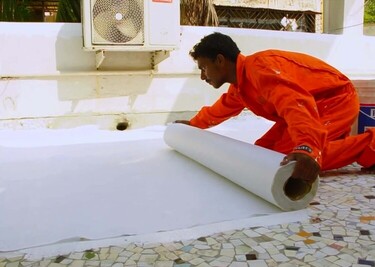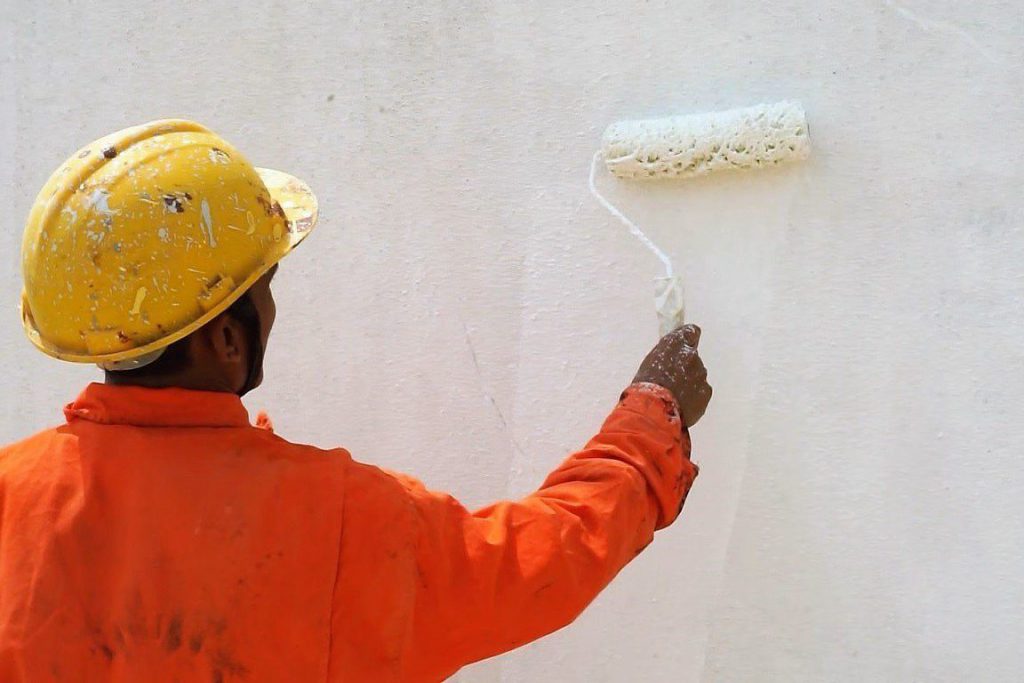Water seepage through exterior walls is more than just an eyesore — it’s a serious threat to your home’s structure and hygiene. Whether it’s the monsoon rains or high humidity, prolonged exposure to moisture can cause exterior walls to crack, paint to peel, and Mold to thrive.
Fortunately, exterior wall waterproofing offers an effective solution that keeps your walls safe, dry, and long-lasting. In this blog, we’ll break down what causes seepage, why waterproofing works, the best methods to use, and how to keep your building protected year-round.

What Causes Seepage in Exterior Walls?
Before exploring solutions, it’s essential to understand the root cause of the problem. Seepage is usually the result of water penetrating porous wall surfaces due to:
- Cracks in walls or joints
- Use of low-quality plaster or paint
- Broken or inadequate drainage systems
- Weather-related wear and tear
- No existing waterproof layer during construction
When water enters these cracks, it can travel into the inner layers of your wall, causing:
- Dampness
- Paint deterioration
- Fungal or mold growth
- Structural weakening
Once the seepage starts, it only gets worse with time if left untreated. That’s where exterior wall waterproofing proves invaluable.
Why Exterior Wall Waterproofing Is the Most Effective Solution
So, how does waterproofing actually work? Exterior wall waterproofing forms a hydrophobic (water-repellent) barrier around your structure. It prevents water from soaking into the walls and causing internal damage.
Unlike temporary fixes like repainting, waterproofing:
- Seal all entry points for water
- Treats existing cracks and prevents new ones
- Provides long-term protection against moisture
- Reduces interior wall damage from seepage
Waterproofing ensures that your walls stay intact for years, especially in areas with high rainfall or humidity. It’s not just about protecting your walls — it’s about preserving your building’s integrity.
Benefits of Waterproofing the Outer Walls
Waterproofing is more than a fix; it’s an investment in your home’s future. Here’s why:
- ✅ Prevents wall seepage permanently
- ✅ Stops mold and mildew from forming
- ✅ Strengthens the wall surface
- ✅ Improves thermal insulation
- ✅ Reduces long-term repair costs
- ✅ Boosts property value
- ✅ Enhances health by eliminating allergens and fungi
The longer you wait, the more damage seepage can cause. Acting early can save you thousands in future repairs.

Best Methods Used for Exterior Waterproofing
Not all walls require the same treatment. The right method depends on the building’s condition, age, and climate. Below are the most popular and effective waterproofing techniques:
Waterproof Paint and Coatings
One of the simplest yet effective options is applying waterproof paint. These paints are made with hydrophobic materials that repel water.
Types of waterproof coatings include:
- Acrylic-based coatings
- Elastomeric wall coatings
- Cement-based paints
These coatings are UV-resistant, flexible, and ideal for new constructions or minor repairs.
Crack Filling and Sealing
Cracks are the main entry point for water. Sealing them before applying any paint or coat is crucial.
Materials used:
- Polyurethane sealants
- Epoxy fillers
- Acrylic crack sealers
This method ensures no leak goes unnoticed.
Waterproof Plastering
Older buildings may need waterproof plastering, a technique where a special mix of cement, sand, and waterproof additives is used to create a moisture-proof surface.
It provides:
- Enhanced bonding
- High resistance to moisture
- Long-lasting protection for older walls
Ideal Time to Apply Exterior Wall Waterproofing
The best time to waterproof your building is during the dry season, typically before the monsoon arrives.
Avoid applying waterproofing materials during rain because:
- Wet surfaces reduce adhesion
- Materials may not cure properly
- Effectiveness is compromised
Plan your waterproofing project during summer or early pre-monsoon months for maximum effectiveness.
Common Signs That Your Building Needs Waterproofing
If you’re wondering whether your home needs waterproofing, look out for these signs:
- ⚠️ Paint peeling or flaking off
- ⚠️ White chalky deposits (efflorescence)
- ⚠️ Dark patches or damp spots
- ⚠️ Mold, mildew, or algae growth
- ⚠️ Cracks in exterior walls
- ⚠️ Musty smells indoors
These signs mean your building is already absorbing water, and it’s time to act fast.
Exterior Waterproofing for Old vs. New Buildings
Old Buildings
Older structures often come with issues like:
- Aged plaster
- Pre-existing damp patches
- Deep cracks
These may require more intensive treatments, such as chemical waterproofing, plastering, and professional-grade sealants.
New Buildings
New buildings are a blank slate — the ideal time for preventive waterproofing. Applying waterproof coatings early protects your investment before issues even begin.
Whether old or new, waterproofing is non-negotiable for long-term durability.
How to Choose the Right Waterproofing Contractor
A good contractor is just as important as good materials. Here’s how to choose the right one:
- ✔️ Experience in exterior waterproofing
- ✔️ Verified customer reviews
- ✔️ Transparent cost and warranty
- ✔️ Site inspection before quoting
- ✔️ Use of branded, certified materials
Don’t just go for the cheapest option — go for proven results. A poor waterproofing job will only cost more in the long run.
Maintenance Tips After Waterproofing Is Done
Waterproofing is highly effective — but it’s not forever. Regular maintenance is essential to retain its benefits.
Here’s how to keep your walls protected:
- 🔍 Inspect walls every 6 months
- 🧹 Clear out roof gutters and drains
- 🎨 Reapply waterproof coatings every 5–7 years
- 🛠️ Repair new cracks immediately
- 🚫 Avoid drilling or damaging treated surfaces
Routine upkeep ensures your waterproofing lasts and your walls stay dry and damage-free.
Final Thoughts: Stop Seepage Before It Spreads
Exterior wall waterproofing isn’t just a repair job — it’s a proactive shield for your property.
By investing in waterproofing, you:
- 🛡️ Stop seepage before it worsens
- 🧱 Protect the structure of your home
- 💸 Save on long-term maintenance costs
- 🧘♂️ Ensure a healthy, moisture-free indoor environment
Don’t wait for visible damage. Address moisture at the source — the outer wall. With the right waterproofing strategy and regular maintenance, your building will stand strong against the elements for decades to come.
Waterproofing is highly effective — but it’s not forever. Regular maintenance is essential to retain its benefits.
Here’s how to keep your walls protected:
- 🔍 Inspect walls every 6 months
- 🧹 Clear out roof gutters and drains
- 🎨 Reapply waterproof coatings every 5–7 years
- 🛠️ Repair new cracks immediately
- 🚫 Avoid drilling or damaging treated surfaces
Routine upkeep ensures your waterproofing lasts and your walls stay dry and damage-free

Interesting read! Just like a solid chess defense protects the king, exterior wall waterproofing protects buildings from seepage. Prevention is always better than cure – both in chess and in construction!”
Very informative blog! Exterior wall waterproofing is indeed one of the best ways to stop seepage and protect the structure in the long run. Just like waterproofing safeguards your home, investing in safe and reliable farmland properties, such as those from mahabhoomi.site
, ensures security for your future. Both are about making the right protection-oriented choices.